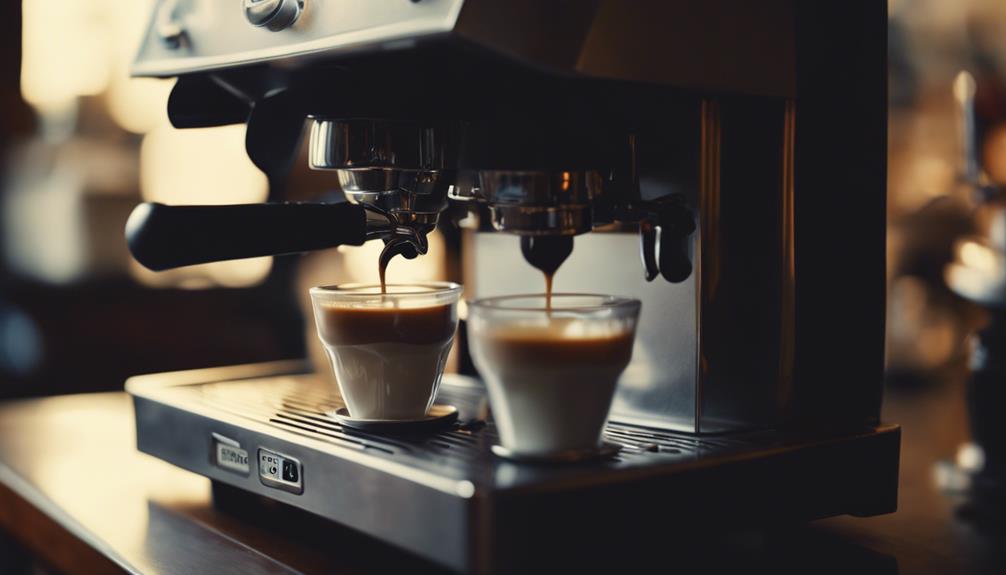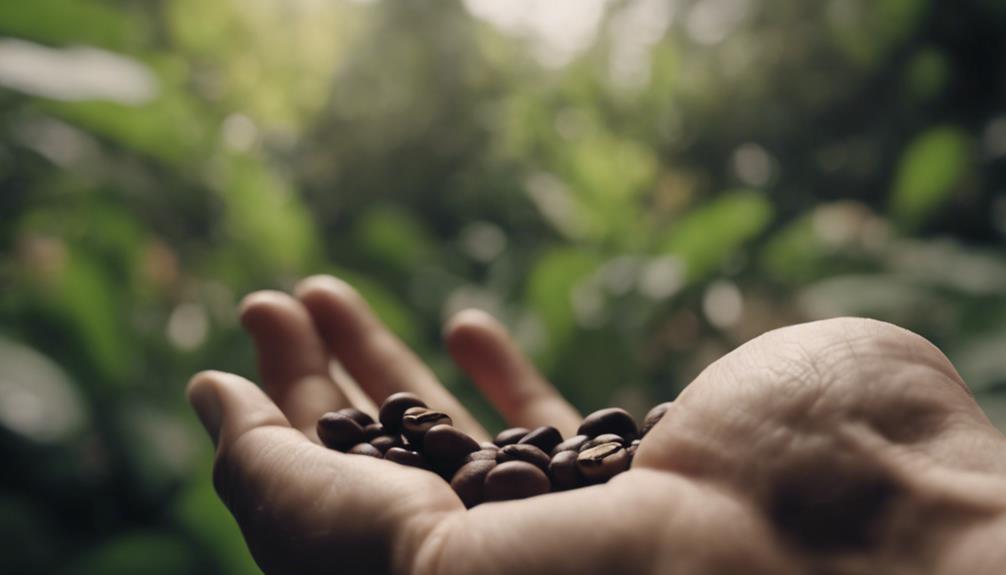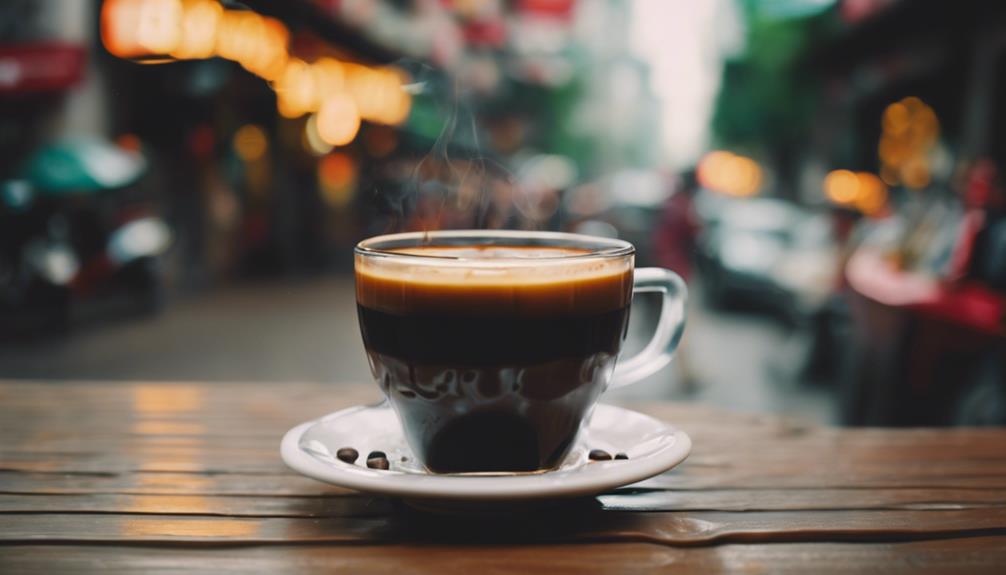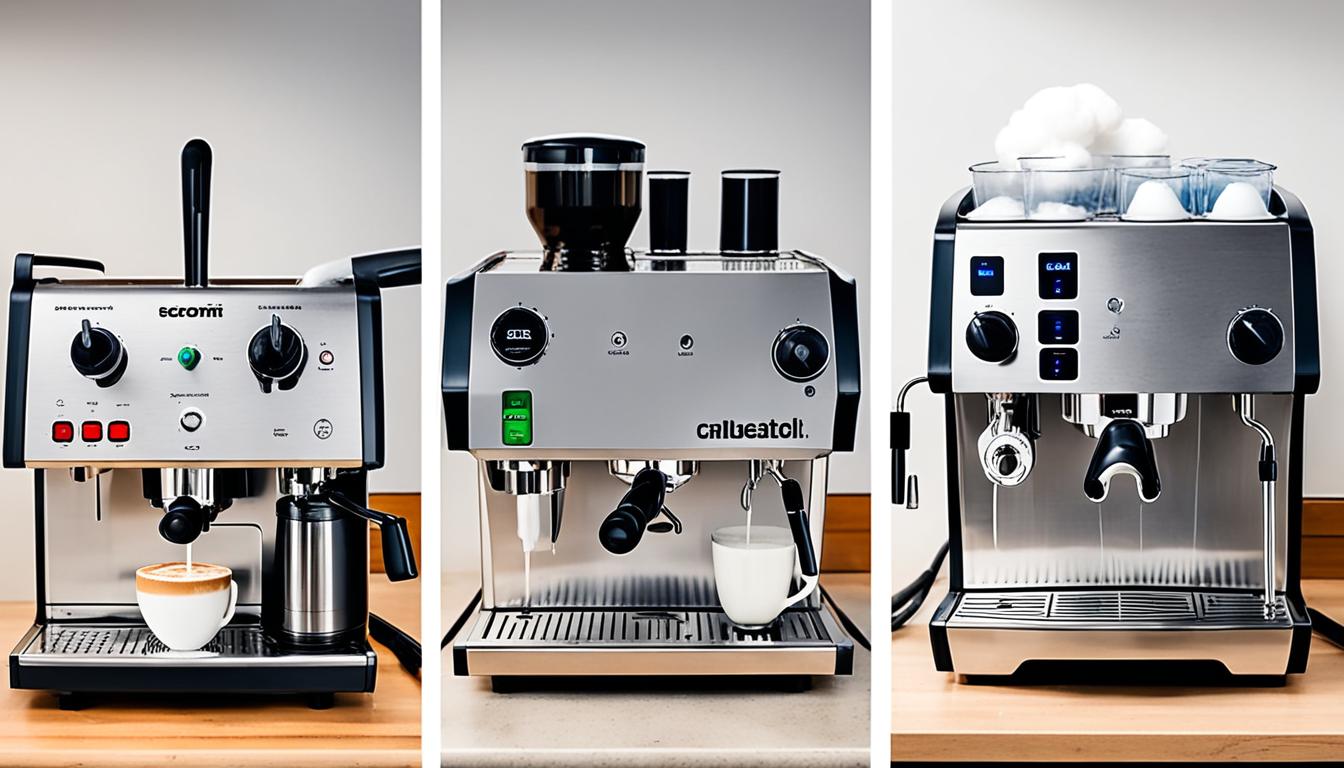As you delve into the world of espresso, you will uncover a decadent, smooth coffee experience that is bursting with flavor and a burst of energy. Espresso is created by forcing hot water through finely ground coffee beans under high pressure, resulting in a concentrated beverage with a thick, creamy crema on top. With around 64 milligrams of caffeine per shot, it is a favorite choice for coffee enthusiasts looking for a pick-me-up. From traditional espresso to lattes, cappuccinos, and more, there are endless ways to savor this beloved brew – and you are about to learn all the exciting details that will elevate your appreciation to new heights!
Key Takeaways
- Espresso is a concentrated coffee beverage made by forcing pressurized hot water through finely ground coffee beans.
- The traditional brewing process produces a thick, velvety crema layer on top, indicating freshness and quality.
- A standard shot of espresso measures 1-2 ounces, containing approximately 64 milligrams of caffeine.
- The flavor profile of espresso is influenced by the type of coffee bean and roast level, with dark roasts offering a bolder taste.
Understanding Espresso Basics
As you explore the world of espresso, it's essential to grasp the fundamental principles that set this concentrated coffee beverage apart from its brewed counterparts.
The brewing process is what makes espresso unique, involving the forceful passage of hot water through finely ground coffee beans at an astonishing high pressure of around 9 bars.
This process yields a shot that's not only rich in flavor but also topped with a velvety layer of crema, a hallmark of freshness and quality.
With a standard shot typically measuring 1-2 ounces, you can expect a caffeine content of approximately 64 milligrams, making it a quick energy boost.
The type of coffee beans used can greatly impact the flavor profile, and espresso can be made from any variety, although the roast level and bean type will influence the final taste.
When you understand these basics, you'll be better equipped to appreciate the complexity and richness of a well-crafted shot of espresso.
Espresso Vs. Coffee: Key Differences
You've likely wondered what sets espresso apart from its more laid-back, brewed counterpart, and the differences are more than just a matter of degree.
When it comes to espresso vs. coffee, the brew method is a key distinction. Espresso is brewed using high-pressure brewing, typically around 9 bars, whereas regular coffee relies on gravity-based methods. This difference in brewing techniques yields distinct flavor profiles.
A single shot of espresso, usually 1-2 ounces, is made from dark roast coffee, giving it a thicker and richer flavor. In contrast, regular coffee often uses lighter roasts, producing a milder taste.
The texture of espresso is also denser and creamier due to the layer of crema formed on top during the brewing process. While both can share similar calorie counts when consumed black, espresso is often perceived as a more concentrated and flavorful option.
Whether you prefer strong espresso or milder coffee drinks, understanding these key differences can help you appreciate the unique qualities of each.
Caffeine Content and Health Aspects
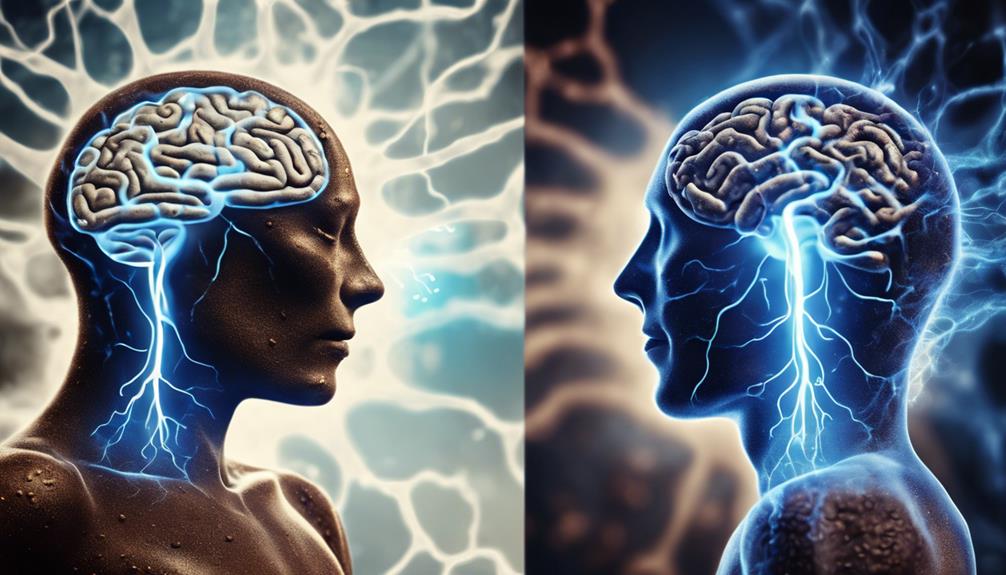
As you consider your daily espresso habit, you're probably wondering about the caffeine content and its impact on your health.
You're likely curious about how much caffeine is in a shot of espresso compared to a regular cup of coffee.
Let's take a closer look at the caffeine content of espresso and how it fits into your daily intake.
Caffeine Content Explained
Get ready to fuel up with a concentrated dose of caffeine, because a single shot of espresso packs a considerable punch, with approximately 64 milligrams of caffeine per serving.
Despite being smaller in size, espresso can deliver a stronger caffeine kick than regular coffee due to its concentrated brewing method. When you order espresso-based drinks like lattes or Americanos, you're often getting two or more shots, which can greatly increase the overall caffeine content.
Moderate consumption of espresso, up to 3-4 shots a day, typically remains within the recommended daily limit of 400 milligrams of caffeine for adults.
However, it's important to remember that caffeine levels can vary based on factors like coffee bean type, grind size, and brewing method. This means that the amount of caffeine in your espresso can differ depending on the machine and beans used.
Espresso Vs. Coffee Caffeine
When it comes to caffeine content, the age-old debate between espresso and coffee often leads to misconceptions. Many assume regular coffee packs a stronger punch due to its larger serving size, but the truth is that a single shot of espresso can deliver a more concentrated dose of caffeine.
In reality, an eight-ounce cup of regular coffee contains about 92 milligrams of caffeine, while a single shot of espresso packs around 64 milligrams. However, since espresso is typically served in smaller quantities (1-2 ounces), you may end up consuming less caffeine overall.
The difference between espresso and coffee becomes more apparent when considering brewing methods and serving sizes. High-quality espresso drinks often use two or more shots, considerably increasing their overall caffeine content compared to standard coffee servings.
Additionally, the amount of coffee used and the brewing methods employed can affect the caffeine content in both espresso and coffee. As you explore the world of espresso, remember that moderate consumption, around 3-4 shots per day, typically remains within the recommended daily caffeine limit of 400 milligrams for adults.
Daily Caffeine Intake
You're likely wondering how your daily caffeine intake from espresso consumption affects your overall health, and it's essential to understand the caffeine content and its implications. A single shot of espresso typically contains about 64 milligrams of caffeine, while an eight-ounce cup of coffee has approximately 92 milligrams. The recommended daily caffeine intake for adults is up to 400 milligrams, allowing for about 3-4 shots of espresso within this limit.
Here's a breakdown of the caffeine content in different beverages:
| Beverage | Caffeine Content (mg) | Calories |
|---|---|---|
| Shot of Espresso | 64 | <5 |
| 8 oz Cup of Coffee | 92 | 0-2 |
| 12 oz Can of Soda | 39 | 150-200 |
| Energy Drink (8 oz) | 80-120 | 100-200 |
Moderate coffee consumption, including espresso, may be associated with a reduced risk of type 2 diabetes and Alzheimer's disease due to its antioxidant properties. However, caffeine can impact anxiety levels regardless of quantity, necessitating personal awareness and moderation in consumption. Be mindful of your daily caffeine intake and enjoy your espresso in moderation to reap its benefits while minimizing its drawbacks.
Popular Espresso Drinks and Variations
Espresso's rich flavor profile has led to the creation of a diverse range of popular drinks and variations that cater to different tastes and preferences.
As you explore the world of espresso, you'll discover that it serves as the foundation for various beloved drinks.
Some popular espresso-based drinks include:
- Latte: a shot of espresso topped with steamed milk and often flavored syrups, providing a creamy and sweet experience.
- Cappuccino: equal parts espresso, steamed milk, and milk foam, resulting in a rich, frothy beverage that highlights the espresso's boldness.
These variations offer a range of flavor profiles, from the bold and rich to the smooth and creamy.
You can also experiment with unique dessert drinks like Affogato, which combines a shot of hot espresso with a scoop of gelato, creating a delightful contrast of temperatures and flavors.
With so many options, you're sure to find an espresso drink that suits your taste buds.
Espresso Roasts and Brewing Methods
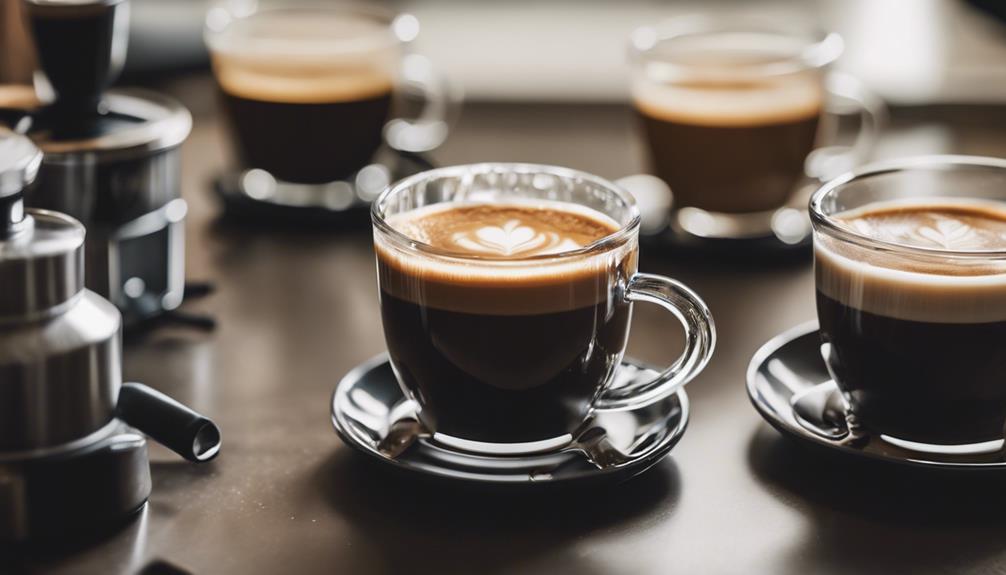
As you explore the world of espresso, you'll find that the type of roast and brewing method you use can greatly impact the flavor and quality of your shot.
Espresso roasts are typically dark roasted, which enhances the coffee's bold flavor and reduces acidity. However, lighter roasts, known as blonde espresso, provide a milder taste with more pronounced fruity notes.
When it comes to brewing, the ideal grind size is fine, akin to table salt, allowing for an excellent extraction during the brewing process.
The brewing method you choose is also essential. Traditional espresso machines, Moka pots, and Aeropress are popular options. Regardless of the method, the coffee-to-water ratio typically starts at 1:2, ensuring a concentrated and rich flavor.
The extraction time is also critical, with 25 to 30 seconds being the perfect time frame for achieving the desired flavor profile and crema quality.
History and Culture of Espresso
In Italy, the birthplace of espresso, a rich cultural heritage has grown around this iconic beverage, shaping the way people consume and appreciate coffee worldwide. You might be surprised to learn that espresso has a fascinating history that dates back to the late 19th century.
Here are some key milestones that have contributed to the evolution of espresso culture:
- In 1884, Angelo Moriondo patented the first espresso machine, marking the beginning of a new era in coffee preparation.
- Luigi Bezzera and Desiderio Pavoni developed the modern espresso machine in 1906, revolutionizing the way coffee was made and enjoyed.
Today, espresso culture has spread globally, influencing coffee trends and the development of espresso-based drinks in various countries. Italy's rich espresso tradition, including the ritual of enjoying a quick shot at the bar, has shaped perceptions and practices surrounding coffee consumption worldwide.
As you explore the world of espresso, you'll discover a rich history and cultural significance that's sure to enhance your appreciation for this beloved beverage.
Frequently Asked Questions
What Do You Need to Know About Espresso?
When it comes to espresso, you need to know it's a concentrated coffee made under high pressure, with a unique flavor profile influenced by beans, roast, and brewing method, and requires precise brewing techniques for ideal taste. Additionally, the caffeine content in Starbucks espresso can vary depending on the size and type of drink you order. A single shot of espresso typically contains around 63 milligrams of caffeine, while a double shot contains around 125 milligrams. However, keep in mind that these numbers may fluctuate slightly depending on the specific blend and brewing process used by Starbucks. Overall, understanding the nuances of espresso and its caffeine content can help you make more informed choices when ordering your next coffee.
What Are the 4 Qualities of Espresso?
You're wondering what makes a great espresso, right? Well, there are four key qualities to focus on: crema, body, acidity, and flavor, each playing an essential role in creating a rich and balanced espresso experience.
What Are 3 Essential Requirements for a Coffee to Be an Espresso?
You're wondering what makes a coffee an espresso? To qualify, it must be brewed with high pressure, use finely ground coffee, and be made with hot water to achieve that perfect shot.
What Are the Golden Rules of Espresso?
You're mastering espresso-making! The golden rules of espresso are: use freshly roasted beans, maintain a consistent brewing temperature, apply ideal pressure, aim for the right brew time, and experiment with the coffee-to-water ratio.
Conclusion
As you've now navigated the rich world of espresso, you're probably buzzing with excitement, just like a 1920s flapper sipping on a Prohibition-era latte.
In all seriousness, espresso is more than just a caffeine kick – it's an art form, a cultural phenomenon, and a delicious addition to your daily routine.
So go ahead, grab your favorite espresso drink, and toast to the perfect blend of tradition and innovation that's been brewing for centuries!
